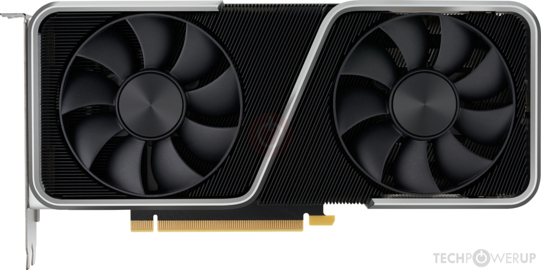T0@st
News Editor
- Joined
- Mar 7, 2023
- Messages
- 3,328 (3.91/day)
- Location
- South East, UK
| System Name | The TPU Typewriter |
|---|---|
| Processor | AMD Ryzen 5 5600 (non-X) |
| Motherboard | GIGABYTE B550M DS3H Micro ATX |
| Cooling | DeepCool AS500 |
| Memory | Kingston Fury Renegade RGB 32 GB (2 x 16 GB) DDR4-3600 CL16 |
| Video Card(s) | PowerColor Radeon RX 7800 XT 16 GB Hellhound OC |
| Storage | Samsung 980 Pro 1 TB M.2-2280 PCIe 4.0 X4 NVME SSD |
| Display(s) | Lenovo Legion Y27q-20 27" QHD IPS monitor |
| Case | GameMax Spark M-ATX (re-badged Jonsbo D30) |
| Audio Device(s) | FiiO K7 Desktop DAC/Amp + Philips Fidelio X3 headphones, or ARTTI T10 Planar IEMs |
| Power Supply | ADATA XPG CORE Reactor 650 W 80+ Gold ATX |
| Mouse | Roccat Kone Pro Air |
| Keyboard | Cooler Master MasterKeys Pro L |
| Software | Windows 10 64-bit Home Edition |
The NVIDIA RTX 4000 SFF Ada Generation graphics card was released to the public in late April, but very few reviews and benchmarks have emerged since then. Jisaku Hibi, a Japanese hardware site, has published an in-depth evaluation that focuses mostly on gaming performance. The RTX 4000 Ada SFF has been designed as a compact workstation graphics card, but its usage of an AD104 die makes it a sibling of NVIDIA's GeForce RTX 4070 and 4070 Ti gaming-oriented cards. Several PC hardware sites have posited that the 70 W RTX 4000 Ada SFF would "offer GeForce RTX 3070-like performance," but Jisaku Hibi's investigation points to the RTX 3060 Ti being the closest equivalent card (in terms of benchmark results).
According to the TPU GPU database: "NVIDIA has disabled some shading units on the RTX 4000 SFF Ada Generation to reach the product's target shader count. It features 6144 shading units, 192 texture mapping units, and 80 ROPs. Also included are 192 tensor cores which help improve the speed of machine learning applications. The card also has 48 ray tracing acceleration cores. NVIDIA has paired 20 GB GDDR6 memory with the RTX 4000 SFF Ada Generation, which are connected using a 160-bit memory interface. The GPU is operating at a frequency of 1290 MHz, which can be boosted up to 1565 MHz, memory is running at 1750 MHz (14 Gbps effective)." The SKU's 70 W TGP and limited memory interface are seen as the card's main weak points, resulting in average clock speeds and a maximum memory bandwidth of only 280 GB/s.




Jisaku Hibi's benchmark tests show that the RTX 4000 SFF performs nearest to the Ampere-based (GA104) GeForce RTX 3060 Ti, while consuming 65% less power. The older card was a bit faster, by a maximum 13% margin, but its total graphics power (TGP) is 200 W. The RTX 4000 SFF's newer architecture allows for impressive efficiency, and it beats the RTX 3060 (non-Ti) 170 W card by a 20% margin. It cannot keep pace with the substantially larger and power hungry RTX 3070 and 4070 GPUs.




It is good to know that the small form factor RTX 4000 GPU is versatile beyond its core purpose - but the high asking price ($1250-1500) makes it a sensible choice for visual professional-type buyers only.
View at TechPowerUp Main Site | Source
According to the TPU GPU database: "NVIDIA has disabled some shading units on the RTX 4000 SFF Ada Generation to reach the product's target shader count. It features 6144 shading units, 192 texture mapping units, and 80 ROPs. Also included are 192 tensor cores which help improve the speed of machine learning applications. The card also has 48 ray tracing acceleration cores. NVIDIA has paired 20 GB GDDR6 memory with the RTX 4000 SFF Ada Generation, which are connected using a 160-bit memory interface. The GPU is operating at a frequency of 1290 MHz, which can be boosted up to 1565 MHz, memory is running at 1750 MHz (14 Gbps effective)." The SKU's 70 W TGP and limited memory interface are seen as the card's main weak points, resulting in average clock speeds and a maximum memory bandwidth of only 280 GB/s.




Jisaku Hibi's benchmark tests show that the RTX 4000 SFF performs nearest to the Ampere-based (GA104) GeForce RTX 3060 Ti, while consuming 65% less power. The older card was a bit faster, by a maximum 13% margin, but its total graphics power (TGP) is 200 W. The RTX 4000 SFF's newer architecture allows for impressive efficiency, and it beats the RTX 3060 (non-Ti) 170 W card by a 20% margin. It cannot keep pace with the substantially larger and power hungry RTX 3070 and 4070 GPUs.




It is good to know that the small form factor RTX 4000 GPU is versatile beyond its core purpose - but the high asking price ($1250-1500) makes it a sensible choice for visual professional-type buyers only.
View at TechPowerUp Main Site | Source









